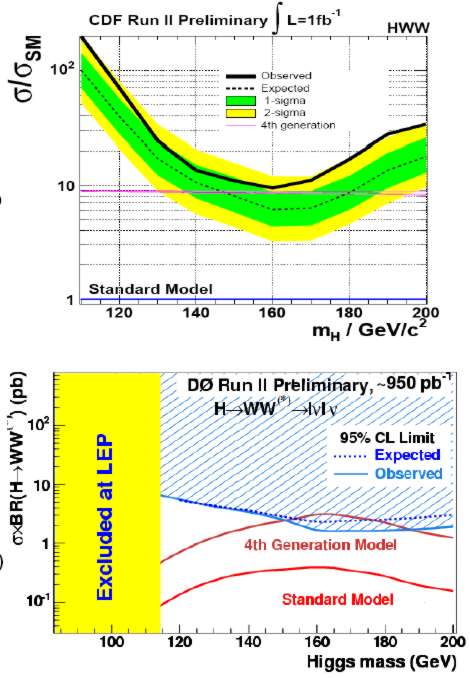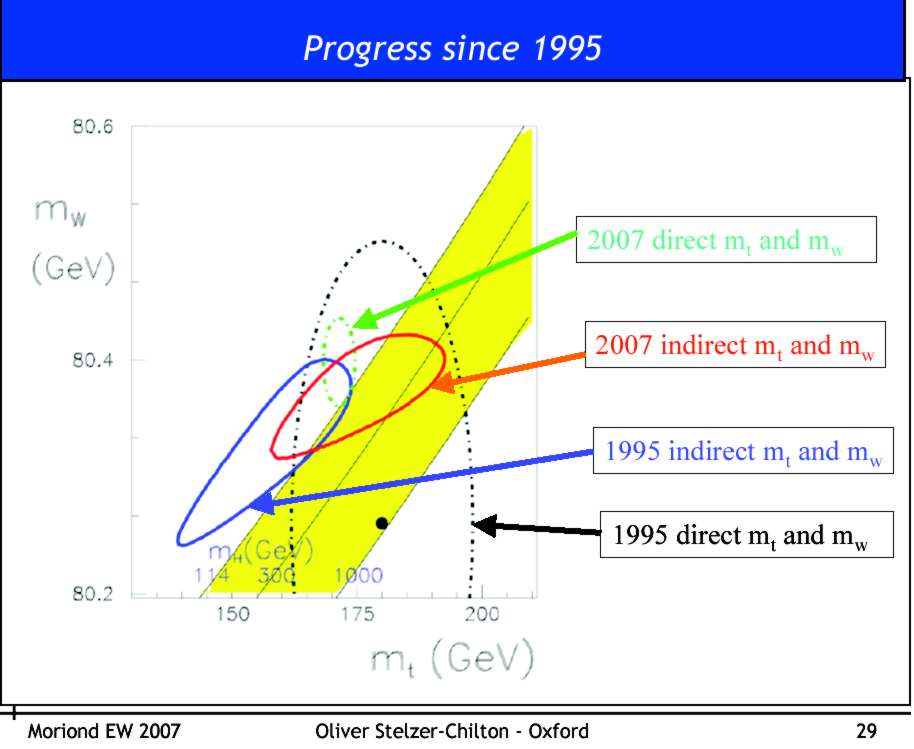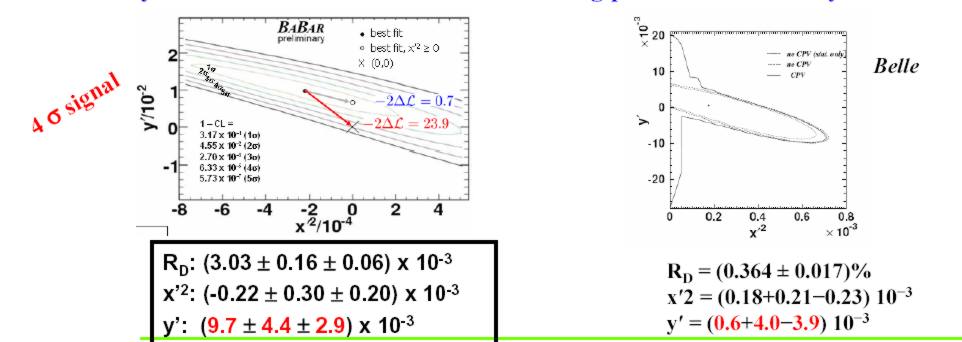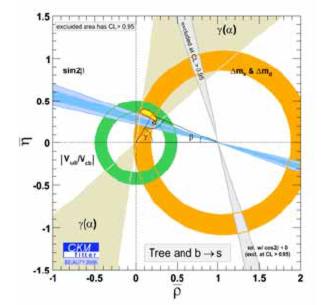XLIInd
Rencontres
de Moriond , March 10-17th, 2007
About this presentation
The present document does
not aim at providing a detailed specialist account of the latest
developments
in particle physics presented and discussed in depth at the Rencontres
de Moriond.
Our purpose is rather here to
present in rather general terms some key points of the
meeting,
dealing both with the scientific content and with the specific format
which
makes the Rencontres de Moriond a unique venue.
We will thus refer the
professional
particle physicist directly to the summary talks by Antonio Masiero
and Bruno Mansoulie, and the detailed scanned
slides (or later to the proceedings)
where
the details of each presentation can be examined freely.
We also welcome enquiries from
information professionals: beyond the ground material found below, we
encourage
them to contact the members of the program committee (the simplest is
to
proceed via the Moriond secretariat, see at end of this file).
In the following paragraphs,
"background
" information is printed in italics.
"Basics of" ... a new (experimental)
Moriond feature?
Moriond is an exceptional
conference, notably by the wide scope of the subjects discussed (from
flavour to symmetry breaking, dark matter to extra dimensions, particle
searches to neutrino and cosmic rays,...). For this reason, we have
asked prominent speakers to provide mini-reviews, or elaborate
introductions to the various topics. We went further this year, with 3
"basics of" commissonned talks, aimed at refreshing the concepts at a
more elementary level. For these "service" talks, we also lifted
experimentally some of our usual umplicit rules (organizers don't
speak, participants don't speak 2 years in a row). Two of the
"basics" were commissionned well in advance (Supersymmetry, by Pierre
Fayet, Neutrinos, by Boris Kayser). A third was commissionned on the
spot, due to the announcement of Dzero mixing (see later): Patricia
Ball accepted to prepare with short notice a critical review of the
theoretical litterature. The experiment was generally considered very
positive, and it is a possiblity which will be kept in mind for future
editions.
Searches and preparation for the Brout-Englert Higgs particle /
Theoretical variants
One of the highlights was certainly the presentation of the current
search results for the scalar bosons associated to electroweak symmetry
breaking.
Direct searches by the Tevatron groups (CDF and D0) don't reach the
sensitivity to confirm or exclude the minimum standard model, but
graphs showing the exclusion zone as a function of mass reach cross
sections typically one order of magnitude above it. Considerable
progress has been made in the analysis of individual channels, and
further significance is expected in the future from:
- improved analysis and understanding of backgrounds
- increased statistics, with a well-running accelerator now in
operation
- inclusion and combination of more decay channels.
 It is
interesting to see that already some variants (for instance with just
one extra generation) can already be excluded for a relevant range of
parameters. How far this will lead before the start of LHC is certainly
an exciting suspense!
It is
interesting to see that already some variants (for instance with just
one extra generation) can already be excluded for a relevant range of
parameters. How far this will lead before the start of LHC is certainly
an exciting suspense!
In parallel, the LHC teams prepare their analysis, and plan for the
first years.
Meanwhile,
theoretical models are diversifying, and in some way simplifying!
Besides the heavy machinery of the Supersymmetry fits, other TeV energy
completion schemes are considered. In particular, the possibility that
the Brout-Englert-Higgs excitations would be spread over 2 or several
peaks (by the simple addition of singlets), or even over a continuous
mass distribution was reminded by J Van Der Bij. In that case, some of
the events observed at LEPII might even be part of the signal. This
could however be quite frustrating for collider searches.
Other models try to include "dark matter" in a simple way as extra
scalar particles associated to a discrete symmetry.
 Indirect
limits are constantly improving (with the "1 sigma" ellipse now only
tangent to the SM expectations!) , with progress in the determination
of the W and top mass.
Indirect
limits are constantly improving (with the "1 sigma" ellipse now only
tangent to the SM expectations!) , with progress in the determination
of the W and top mass.
Heavy
flavours at
the center of attention…and the D-anti D mixing.
Heavy flavours made an essential part of the meeting.
After the impressive evidence last year for Bs oscillations from the
Tevatron, we had a more varied, but no less rich set of new data in
2007.
First of all, the top studies are really entering into force, with more
precisely reconstructed decays, and increased precision on the mass.
This is of course an essential element for indirect tests of the
Standard Model. But we see also the first evidence coming for single
top production. (which will in the
future lead to intersting helicity tests of the couplings)
The surprise : D°-anti
D° mixing.
 This first evidence (from different analysis in Belle
and BaBar) came a bit "out of the blude". It is not unfair to say that
theorists had almost given up on this (a notoriously difficult
evaluation, with the decay of the charm quark playing an important
rôle, and the mixing dominated in standard model by long
distance, real K-pion intermediary stated), and estmations span orders
of magnitude. The currernt experimental number (see the Belle and BaBar
talks, and the review- Basic of by P. Ball), came at the upper limit of
those estimations.
This first evidence (from different analysis in Belle
and BaBar) came a bit "out of the blude". It is not unfair to say that
theorists had almost given up on this (a notoriously difficult
evaluation, with the decay of the charm quark playing an important
rôle, and the mixing dominated in standard model by long
distance, real K-pion intermediary stated), and estmations span orders
of magnitude. The currernt experimental number (see the Belle and BaBar
talks, and the review- Basic of by P. Ball), came at the upper limit of
those estimations.
Even so, perspectives for finding "beyond the Standard Model" effects
in this channel are difficult, precisely due to the difficulty of the
evaluations; one would most likely need to favour CP violating effects
for such a search.
As goes without saying, this "Moriond First" called for some
celebration (which the summary speaker dubbed the "D° mix
cocktail")

B physics and CKM fits 
Achievements in individual and rare decays of B's keep adding.
Meanwhile, the issue of the CP mixing angles is not completely sorted
out.
In particular, some tension exists between the "gold plated"
determination of sin(2 beta) , and that coming through "Penguin modes".
(one should also mention the attention to direct measurement of Vub).
Let us note that some tension also persists in the unitarity of the CKM matrix,
(the "u" column)
K physics
Here also, precision measurements abound, see details in the summary
talks.
Neutrinos
consolidation and waiting…
<>Amongst the most
discreet existing
particles,
neutrinos were first conjectured to account for escaping momentum and
energy
in weak decays. Nowadays well established members of the standard model
of electroweak interactions, it is now established that they have mass,
and that the various flavours mix (as do the quarks, but with very
diffetrent characteristics). The mass differences are estimated by
"oscillations" , while the absolute masses (and their nature :
Dirac , i.e. lepton-number conserving or Majorana) are not
establised. Whether the presence of neutrino masses (which
implies either right handed neutrinos or extra scalar fields) is
departure from the "Standard Model' is merely a matter of definition or
history; except maybe for Majorana masses, the changes are minimal ,
and similar to those introduced when generalising the Standard Model to
include more quark families; in any cases, the "gauge structure" is
unaffected.
Striking changes in our conception of neutrinos have been brought in
the past few years, and the present period is more a time for
consolidation.
At the time of the Moriond meeting, the MiniBoone data were not
available yet ( but we got a detailed study of the systematics and
expectations) -- (at the time of
writing this summary it is now known that they don't agree with LSND in
an oscillation context)
Meanwhile, neutrinos have also become an
"astronomical" tool, with large neutino telescopes entering
a new era (the larger IceCube is developing Amanda at the South Pole,
Antares as started its deployment and seen first light).
An interesting approach to more general neutrino mixing was brought by
B. Gavela, in a genric non-unitary mixing analysis (it is well known that mixing with heavy or
sterile states can induce some non-unitarity in the 3X3 reduced matrix,
but we are dealing here with a generic approach)
The understanding of neutrino masses, mixing and CP violation is also
critical for our understanding of Leptogenesis, a possible pathway to
explain the victory of matter against antimatter in our observed
Universe! -- more about this later.
Improved limits are also reported on neutrinoless double beta decay,
despite a continuiing controversy.
<>
Beyond the
Standard Model,
Supersymmetry and string-inspired models
Extra- dimensions
With the increasing luminosity of
Fermilab's Tevatron, and the coming of CERN's LHC, the next question is
clearly our understanding of the symmetry breaking which differentiates
dramatically the "unified" forces governing week interactions and
electromagnetism. While the simplest mechanism (but not necessarily the
most elegant) uses the famed (but still to be found)
Brout-Englert-Higgs partile, a number of alternatives have been
proposed, from dynamical symmetry breaking to very intricate models,
which typically extend towards the higher energies the search domain.
Supersymmetry, while usually associated with the minimal version of the
Standard model, can even involve such new mechanims, notably as an
additional way to stabilize the electroweak scale, but stays mostly the "typical" extension used in
numerous analysis to prepare the upcoming experiments.
We had impressive reviews of Supersymmetry, including new
breaking patterns, compared to
the latest results showing the strong experimental constraints on such
contributions.
An important tendency is the study of neutral flavour-changing
interactions, now considerably extended to the leptonic sector, where
very sensitive tests not only exist, but will be considerably
developped.
Extra dimensions, long the province of
string theories and characterized by unreachable scales
have
become a studied possibilty, even at the TeV ranges, which
makes
them open to experimental investigation.
Matter-antimatter
asymmetry, dark matter, cosmological constant, high energy cosmic rays.
With the "concordance" model now generally
accepted (but with some reserves, see for instance the presentation by
), theorist's attention turns to
explaining why the contributions of baryonic matter, dark matter, and
dark energy (with furher speculations about its nature) are currently
of comparable sizes. (or at least not vastly different). The defeat of
antimatter (in a Universe thought to be initially symmetrical) is also
an important feature, linked to CP violation.
Leptogenesis is obviously a favourite model for generating
the matter-antimatter asymmetry, but in a way, it becomes even too
successfull and robust, at the point of being difficult to infirm.
While it was initially argued that serious constraints on the
(observable) light neutrino mass spectrum were implied by leptogenesis,
it appears now that much more effects can come in play. In particular,
several heavy neutrinos can come into play, as well as scalar particles
coupled to them. A recently stressed aspect (flavour leptogenesis) also
considers the possibility that part of the lepton number be sequestered
in family flavours, which makes it resistant to later wash-out by
lighter Majorana exchanges.
As a result, and while some calculations need to be re-considered, the
impression is that the mechanism becomes even more robust, up to the
point that devising low-energy tests becomes a real challenge.
Meanwhile, other alternatives continue to be explored, notably the
electroweak-scale baryogenesis (impossible in the Standard Model, but
approached typically in a supersymmetric context).
Direct searches for dark matter, either in the form of "WIMPS", like
the Lightest Supersymmetric Particles, or as the less conventional
Axions, is also a domain
where experiments are reporting results approaching the required
sensitivity. At the time of Moriond, the PVLAS results were still in
conflict with other searches in a traditional axion searches. As a
result, a number of new experiments are either starting or being
planned.
The AUGER experiment is largely deployed by now, but the final verdict
on the GZK cut-off events is still to come.
(note: in particular, the relative
calibration of the air showers vs ground detectors is clearly an issue
to be solved, and for which
new experimental work is in progress,
but on which final results were not yet reported)
Outstanding
questions and precision tests
The muon "g-2" measurement remains somewhat of a puzzle.
Here, much of the debate comes from the extraction of the vacuum
polarization effects from data. Traditional methods (accelerators)
yield a 3.4 sigma difference, but tau decay only 1 sigma... this stays
an open question, with the theory behind experiment.
Gravity at short distance, quantum coherence in the B system are other
examples of such tests.
A special word about the Rencontres de Moriond
For 40 years now, the Rencontres
de Moriond, initiated by a small group of physicists around Professor
Tran
Thanh Van, have brought together scientists from around the world in a
unique conference format.
The size of the meeting is voluntarily
limited,
to ensure a maximum of personal contact, and to avoid parallel
sessions:
all the presentations occur in plenary sessions, with strict
instructions
for experimenters to aim their talks at theorists and vice versa.
Considerable
time is foreseen for general discussions between the talks, and special
extended discussions are set up by the organizers as the need arises .
More important however are the private
discussions,
in particular between theorists and experimenters, where projects can
develop.
An extended break in a long working day, and the setting in a winter
sports
resort do a lot to promote a relaxed and confident atmosphere, which
facilitates
such communication.
Another striking feature is the wide age range
of participants, but here, the senior staff tends to stay in the
audience
and bring comments and suggestions while presentations are made by the
young scientists who conducted the detailed analysis. Often this is
their
first international meeting, (and for this European support plays
a crucial role) and the quality of their presentations is
impressive.
Further Contacts
The present review is by
essence a subjective presentation of the highlights of the
Rencontres
de Moriond Electroweak2007; remarks and criticisms are welcome :
J.-M.
Frère : frere@ulb.ac.be
detailed in formation on
this
year's "Rencontres de Moriond" and on future related events can be
obtained
from:
Rencontres de Moriond :
http://moriond.in2p3.fr/
 It is
interesting to see that already some variants (for instance with just
one extra generation) can already be excluded for a relevant range of
parameters. How far this will lead before the start of LHC is certainly
an exciting suspense!
It is
interesting to see that already some variants (for instance with just
one extra generation) can already be excluded for a relevant range of
parameters. How far this will lead before the start of LHC is certainly
an exciting suspense!  Indirect
limits are constantly improving (with the "1 sigma" ellipse now only
tangent to the SM expectations!) , with progress in the determination
of the W and top mass.
Indirect
limits are constantly improving (with the "1 sigma" ellipse now only
tangent to the SM expectations!) , with progress in the determination
of the W and top mass.  This first evidence (from different analysis in Belle
and BaBar) came a bit "out of the blude". It is not unfair to say that
theorists had almost given up on this (a notoriously difficult
evaluation, with the decay of the charm quark playing an important
rôle, and the mixing dominated in standard model by long
distance, real K-pion intermediary stated), and estmations span orders
of magnitude. The currernt experimental number (see the Belle and BaBar
talks, and the review- Basic of by P. Ball), came at the upper limit of
those estimations.
This first evidence (from different analysis in Belle
and BaBar) came a bit "out of the blude". It is not unfair to say that
theorists had almost given up on this (a notoriously difficult
evaluation, with the decay of the charm quark playing an important
rôle, and the mixing dominated in standard model by long
distance, real K-pion intermediary stated), and estmations span orders
of magnitude. The currernt experimental number (see the Belle and BaBar
talks, and the review- Basic of by P. Ball), came at the upper limit of
those estimations.
